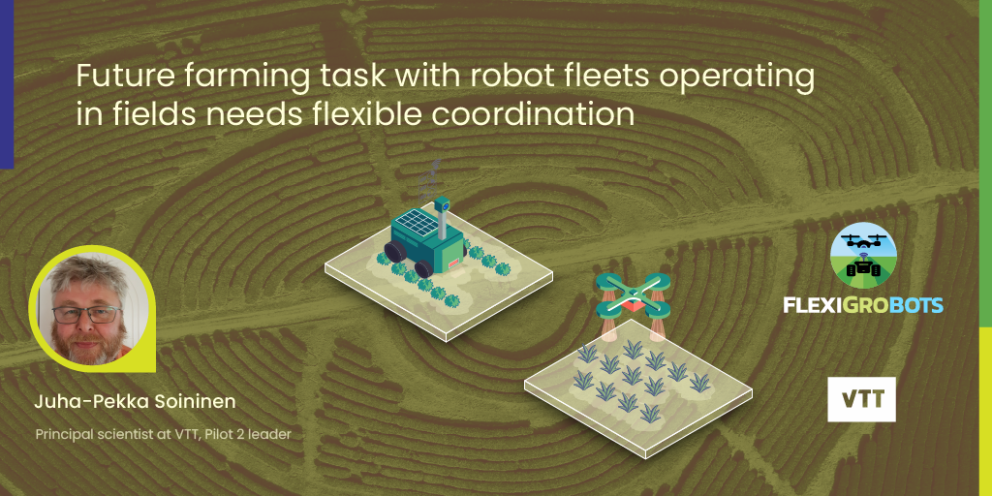The FlexiGroBots project is about the fleets of autonomous robots doing different tasks in the field, and that fleet will be managed, supervised, and controlled by the mission control centre. We created the use cases that used drones, robots, and AI services for various possible farm tasks, we analysed other approaches and the views and opinions of various stakeholders.
The real world and the farm tasks are complex. The on-field fleet operations have dependencies to other workflow phases that cannot be ignored. Later workflow phases can be planned only after the results of the earlier phases are analysed. For example, precision pesticide spraying cannot be planned before the location of pests are known. Integration of robots under the same operation control is challenging, the autonomy levels of robots vary, the robots may have very advanced planning and controlling functionalities, and even the ownership of robots may introduce obstacles for joint operations.
We decided to redefine the mission concept to cover the complete farm task workflows and to create a mission control centre with two coordination and control levels. The motivation was to include the needed functionalities to the mission workflow and to enable a loosely coupled control of robot fleet members, especially in the case of heterogeneous robot fleets based on different standards.
- The first level splits the workflow as a function of time into different phases that are executed separately under the control of the mission manager. The three different categories of phases are: a robot fleet task, a service task, and a user task. The service task is a service that manipulates the existing input data, or data created by robots or other tasks. The user task is an activity where user modifies the data with some tool, such as planning a drone flight plan. The robot fleet task is a task done at the field with one or more robots.
- The second level splits the workflow phase into tasks in space, where tasks are executed in parallel. In robot fleet task each fleet member executes its own task. For controlling such parallel robot operations, the mission control centre has a fleet supervisor and controller that interacts with robot or robot swarm systems and is capable to visualise the whole fleet at the same time. The fleet controller is also capable to control fleet members via their own control systems.
Two-level communication solution will support the two control levels. In the mission workflow part, data sharing is the key issue. Either shared data storages or IDSA data space is used. IDSA is based on a publish-subscribe architecture that allows to implement the control of execution flow across company boarders using its notification features. For the robot fleet management, we have adopted another publish-subscribe architecture, the MQTT. We have defined message formats for exchanging robots’ status data and field controllers command messages. MQTT architecture supports robot-to-robot communications too. Both methods decouple the actual systems/actors making the whole mission easily configurable and adaptable.
Modern mission management goes beyond the control of robot fleet operations. It begins from farmers need in the running of his business. It must have links to the farm management information systems. It also deals with data about robots and drones involved. The must be links to robot management systems in case larger fleets are involved. Robots are relatively expensive devices that need specific skills, at least in the early phases of deployment. Robots as a service, provided by third-party companies will be viable alternatives. Solutions must therefore support networked collaboration of different companies. Finally, the data. The importance of data in agriculture cannot be overestimated. Robots and their sensors will produce a huge amount of data. It will have a huge added value both through the development of more advanced AI, and especially by creating transparency for the whole food production value chain.
FlexiGroBots project is developing a holistic mission control centre that will address the above-mentioned topics. We have the concepts modelled and prototype systems for the fleet and mission management to be tested in the pilots next summer.

